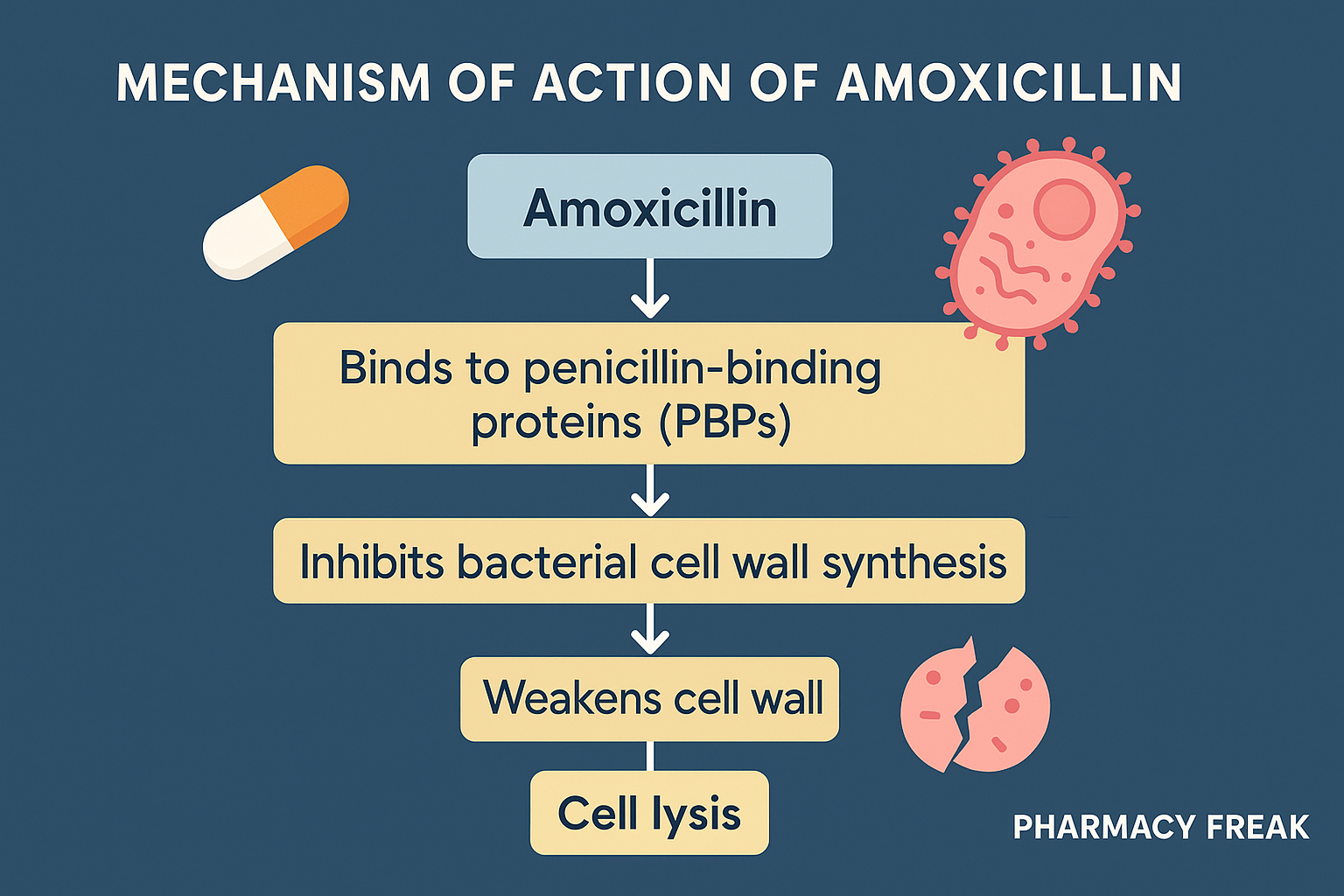Table of Contents
Introduction
Amoxicillin is a widely used broad-spectrum penicillin antibiotic belonging to the β-lactam class. It is effective against a range of gram-positive and some gram-negative organisms, and is one of the most commonly prescribed antibiotics in both outpatient and inpatient settings in the United States.
It is FDA-approved and widely used in:
- Respiratory tract infections
- Otitis media
- Sinusitis
- Urinary tract infections
- Helicobacter pylori eradication (as part of combination therapy)
Because of its clinical relevance and exam frequency, Amoxicillin is essential for students in PharmD, MBBS, B.Pharm, and for exams like USMLE, NCLEX-RN, NAPLEX, GPAT, and NEET-PG.
Stepwise Mechanism of Action of Amoxicillin
- Binding to Penicillin-Binding Proteins (PBPs):
Amoxicillin binds to PBPs located inside the bacterial cell wall, specifically targeting enzymes involved in peptidoglycan synthesis. - Inhibition of Transpeptidation:
It blocks the transpeptidase enzyme, which is responsible for cross-linking peptidoglycan chains — a critical step in bacterial cell wall synthesis. - Cell Wall Weakening:
The inhibition of cross-linking results in a weakened and unstable bacterial cell wall, especially during bacterial cell division. - Cell Lysis and Bactericidal Action:
The weakened wall cannot withstand osmotic pressure, leading to cell lysis and death of the microorganism. Amoxicillin is thus bactericidal, not bacteriostatic. - Limited β-lactamase Resistance:
Amoxicillin is susceptible to β-lactamase enzymes, which can hydrolyze its β-lactam ring. Therefore, it is often combined with clavulanic acid, a β-lactamase inhibitor.
Pharmacokinetic Parameters of Amoxicillin
| Parameter | Value |
|---|---|
| Bioavailability | ~70–90% (oral) |
| Onset of Action | Within 1 hour |
| Half-life | ~1–1.5 hours |
| Protein Binding | ~20% |
| Metabolism | Minimal hepatic metabolism |
| Excretion | Renal (as unchanged drug) |
Clinical Uses of Amoxicillin
- Upper respiratory tract infections (pharyngitis, sinusitis, otitis media)
- Lower respiratory tract infections (bronchitis, pneumonia)
- Urinary tract infections
- Dental infections
- Skin and soft tissue infections
- Helicobacter pylori eradication (in combination with clarithromycin and PPI)
- Prophylaxis for bacterial endocarditis in certain dental procedures
Adverse Effects of Amoxicillin
- Common:
- Diarrhea, nausea
- Rash
- Abdominal discomfort
- Serious (less common):
- Hypersensitivity reactions (anaphylaxis)
- Pseudomembranous colitis (Clostridioides difficile overgrowth)
- Stevens-Johnson syndrome (rare)
- Seizures (with high IV doses in renal impairment)
- Caution:
- Use with caution in penicillin-allergic patients
- Can lead to superinfection if used for prolonged periods
Comparative Analysis: Amoxicillin vs Ampicillin
| Feature | Amoxicillin | Ampicillin |
|---|---|---|
| Spectrum | Broad, better oral absorption | Broad, less oral absorption |
| Oral bioavailability | Higher (~90%) | Lower (~40%) |
| Dosing frequency | Less frequent | More frequent |
| Use in GI infections | Less preferred | More used (e.g., Shigella) |
| Acid stability | More acid-stable | Less acid-stable |
Practice MCQs
Q1. What is the mechanism of action of Amoxicillin?
a. Inhibits protein synthesis
b. Disrupts DNA replication
c. Inhibits bacterial cell wall synthesis ✅
d. Blocks folic acid synthesis
Q2. Which enzyme is inhibited by Amoxicillin?
a. DNA gyrase
b. Transpeptidase ✅
c. Beta-lactamase
d. Topoisomerase IV
Q3. Amoxicillin is primarily excreted through:
a. Liver
b. Lungs
c. Kidneys ✅
d. Skin
Q4. Which of the following bacteria are generally resistant to Amoxicillin alone?
a. Streptococcus pyogenes
b. Haemophilus influenzae
c. Staphylococcus aureus producing β-lactamase ✅
d. Enterococcus faecalis
Q5. Which of the following is a serious but rare adverse effect of Amoxicillin?
a. Tachycardia
b. Stevens-Johnson syndrome ✅
c. Hyperglycemia
d. Thrombocytosis
Q6. Which of the following combinations improves Amoxicillin’s spectrum?
a. Amoxicillin + Rifampin
b. Amoxicillin + Clavulanic acid ✅
c. Amoxicillin + Vancomycin
d. Amoxicillin + Gentamicin
Q7. What is a common gastrointestinal side effect of Amoxicillin?
a. Constipation
b. Diarrhea ✅
c. GERD
d. Flatulence
Q8. Amoxicillin is classified under which group of antibiotics?
a. Cephalosporins
b. Macrolides
c. Penicillins ✅
d. Tetracyclines
Q9. In which condition is Amoxicillin used in combination therapy?
a. Cystic fibrosis
b. H. pylori eradication ✅
c. Malaria
d. Tuberculosis
Q10. Which of the following conditions requires caution when using Amoxicillin?
a. Hypertension
b. Penicillin allergy ✅
c. Hypothyroidism
d. Asthma
FAQs
Q1: Is Amoxicillin bactericidal or bacteriostatic?
It is bactericidal. It kills bacteria by disrupting the cell wall.
Q2: Can Amoxicillin be given to pregnant women?
Yes, it is generally considered safe during pregnancy (Category B).
Q3: How does clavulanic acid enhance Amoxicillin’s effectiveness?
Clavulanic acid inhibits β-lactamase, preventing enzymatic degradation of Amoxicillin.
Q4: What is the difference between Amoxicillin and Augmentin?
Augmentin = Amoxicillin + Clavulanic acid.
References
- KD Tripathi – Essentials of Medical Pharmacology
- Goodman & Gilman – The Pharmacological Basis of Therapeutics
- Review of Pharmacology – Sparsh Gupta
- FDA Drug Label: https://www.accessdata.fda.gov
- NCBI: https://www.ncbi.nlm.nih.gov/books/NBK556036/
I am pursuing MBA in pharmaceutical management from NIPER Hyderabad with a strong academic record and proven success in national-level pharmacy entrance exams. I secured AIR 61 in NIPER 2024 (MS/M.Pharm) and AIR 27 in NIPER MBA, along with AIR 147 in GPAT 2024 and AIR 907 in GPAT 2023. I also achieved AIR 6 in AIIMS CRE-2025 for Drug Store Keeper and was selected as a Pharmacist (AIR 61) for ESIC. Additionally, I was the Runner-Up in Round 2 of the EY Case Study Competition.
At PharmacyFreak.com, I aim to guide future pharmacists through expert content, exam strategies, and insightful resources based on real experience and academic excellence.
Mail- harsh@pharmacyfreak.com
